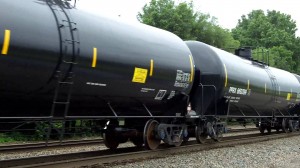 The rapid increase in U.S. oil production has had a number of impacts. One of these is that shipping of crude oil by rail has increased more than 400% since 2005, due to pipeline limitations and the sheer pace of development. On Monday, a train carrying 109 oil cars derailed in West Virginia and 20 of the oil cars exploded. Other recent, high profile accidents have rekindled the discussion about the safety of transporting oil-by-rail that began after a derailment in Quebec in July, 2013 killed 47 people.
The rapid increase in U.S. oil production has had a number of impacts. One of these is that shipping of crude oil by rail has increased more than 400% since 2005, due to pipeline limitations and the sheer pace of development. On Monday, a train carrying 109 oil cars derailed in West Virginia and 20 of the oil cars exploded. Other recent, high profile accidents have rekindled the discussion about the safety of transporting oil-by-rail that began after a derailment in Quebec in July, 2013 killed 47 people.
In July 2014, the Department of Transportation issued a new rule proposal for these crude oil trains in an attempt to address safety concerns. This proposal calls for an upgrade to tank cars, from the older models to newer, safer ones. However, Monday’s crash involved the newer cars, causing some to question the effectiveness of the proposal, although the draft rule would require thicker versions of the new cars than those involved in the accident. The proposed rule also calls for enhanced braking capabilities, speed limits and a controversial timeline for phasing out old cars.
The debate over oil by rail safety will likely continue beyond the final rule’s release (expected in May 2015). Yet some have suggested that safety rules will not address the underlying policy issues that have limited other options for transporting the oil: The Keystone XL Pipeline, the crude oil export ban and the pipeline permitting process, among others.
Is the Department of Transportation’s proposed rail safety rule adequate? What policy approach is the most effective way of dealing with transporting crude oil by rail?
The ‘stabilizer’ can make a difference … not the new rules as the WVa cars met the new rule. Evidently a Wall Street Journal reporter has written a book about… Read more »
Not only explosions from light ends in Bakken crude, but also the risk to groundwater from low gravity crude spills, weigh against crude by rail. Refining closer to the source,… Read more »
“The number of accidents is going up because the oil boom in the U.S. and Canada has dramatically increased the amount of oil shipped by rail. Last year, railroads moved… Read more »